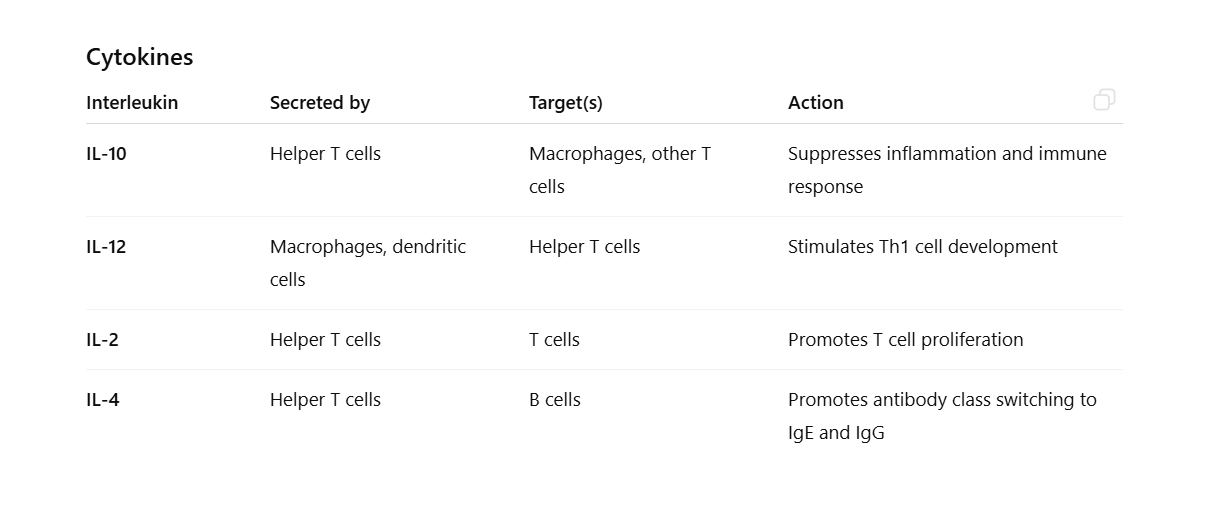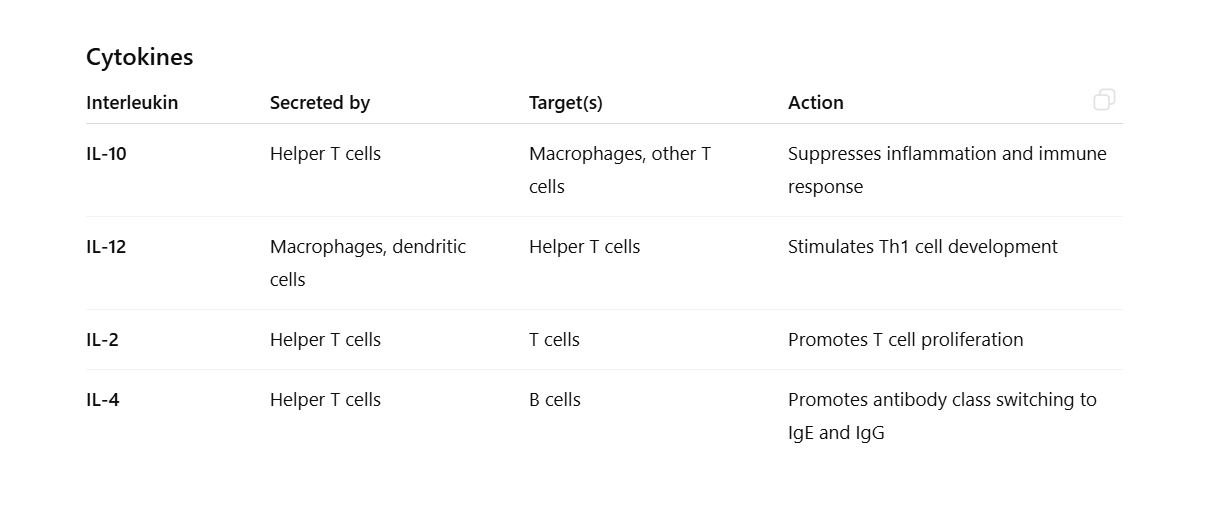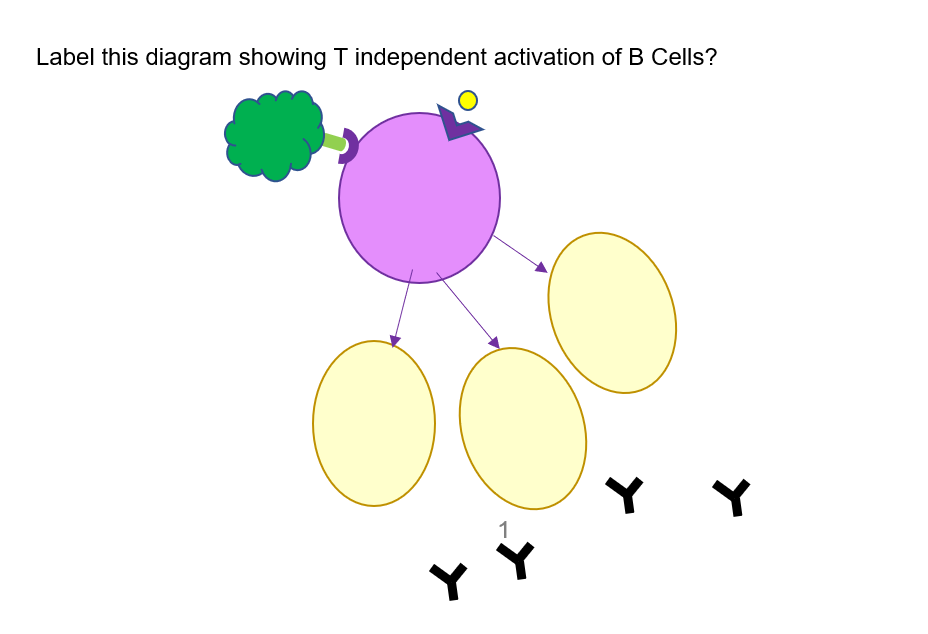Immune Worksheet 2 Lecture Bio 221
1/27
There's no tags or description
Looks like no tags are added yet.
Name | Mastery | Learn | Test | Matching | Spaced |
|---|
No study sessions yet.
28 Terms

Study
Study


Study
Study
What are the 2 arms of specific immunity?
The two arms are cell-mediated immunity and antibody-mediated (humoral) immunity.
What is an antigen?
An antigen is any molecule that triggers an immune response by being recognized as foreign by the body.
What are the 2 types of T cells?
The two main types are Helper T cells (Th) and Cytotoxic T cells (Tc).
What arm of specific immunity involves the Tc cells?
Cell-mediated immunity involves Cytotoxic T cells (Tc).
Which type of T cell participates in both arms of specific immunity?
Helper T cells (Th) participate in both arms — they activate both B cells and Cytotoxic T cells.
What arm of specific immunity involves the B Cells?
Antibody-mediated (humoral) immunity involves B cells.
What is co-stimulation?
Co-stimulation is the second signal required to activate a lymphocyte, preventing accidental immune responses.
Name the five classes of antibodies and give characteristics of each type.
IgG: Most abundant antibody in blood and tissues; crosses the placenta to protect the fetus and provides long-term immunity.
IgA: Found in mucus, saliva, tears, and breast milk; protects mucosal surfaces from infection.
IgM: The first antibody produced during an infection; forms pentamers and is a strong agglutinator.
IgE: Involved in allergic reactions and defense against parasites; binds to mast cells and basophils.
IgD: Found on the surface of B cells; acts as a receptor to help activate B cells.
How does the secretion of antibodies help fight disease?
Antibodies bind to antigens to neutralize pathogens, trigger phagocytosis, and activate complement proteins to destroy invaders.
What does an antigen presenting cell (APC) do?
An APC processes and displays antigens on its surface for recognition by T cells, initiating an immune response.
Give examples of APCs.
Examples include macrophages, dendritic cells, and B cells.
How are naive helper T cells activated?
They are activated when an APC presents an antigen on MHC II and provides co-stimulation.
Helper T cells type 1 stimulate what type of cells?
Th1 cells stimulate Cytotoxic T cells and macrophages for cell-mediated immunity.
Helper T cells type 2 stimulate what type of cells?
Th2 cells stimulate B cells for antibody production.
Distinguish between T independent and T dependent B cell activation.
T-Independent Activation:
B cells are activated directly by antigens without T cell help. The response is weak, short-lived, and does not produce memory cells.
T-Dependent Activation:
B cells require Helper T cell (Th) assistance for activation. The response is strong, long-lasting, and creates memory cells for faster future defense.
What type of T cell is involved in cell-mediated immunity?
Cytotoxic T cells (Tc).
How are these cells activated?
They are activated when antigens are presented on MHC I molecules and Helper T cells provide co-stimulation.
What do these cells do to help get rid of a pathogen?
They destroy infected or cancerous cells by releasing perforin and granzymes that induce apoptosis.
How do memory cells help us develop immunity?
Memory cells remember specific antigens and respond faster and stronger during future infections.
Distinguish between a primary and secondary immune response in terms of antibody response.
Primary Response:
Occurs after the first exposure to an antigen. The response is slow, produces low levels of antibodies, primarily IgM, and develops no immediate memory.
Secondary Response:
Triggered by subsequent exposure to the same antigen. The response is rapid and strong, produces high levels of antibodies, mainly IgG, and is powered by memory cells formed during the primary response.
What is a vaccine?
A vaccine is a preparation containing weakened or inactive antigens that stimulate the immune system to produce memory cells without causing disease.
What is the function of regulatory cells?
Regulatory cells (also called Regulatory T cells or Tₙₑg cells) help control and balance the immune response.
Their main functions are:
Prevent overreaction of the immune system after an infection has been cleared.
Suppress autoimmune responses — stop the body from attacking its own healthy cells.
Release inhibitory cytokines (like IL-10 and TGF-β) that reduce inflammation and calm other immune cells.
Do antigens have epitopes?
✅ Yes.
An epitope (or antigenic determinant) is the specific part of an antigen that is recognized and bound by an antibody or a B/T cell receptor.
One antigen can contain many epitopes, each triggering a different immune response.
Antigens are the whole molecules; epitopes are the smaller regions that the immune system actually detects and binds to.
Memory Tip:
🧠 Antigen = entire target; Epitope = specific “spot” the immune system locks onto.

Label the diagram.
What are the steps for an activated B-cell?
Activation: A B cell binds to its specific antigen and receives activation signals from a helper T cell.
Proliferation: The activated B cell rapidly divides to form a clone of identical cells.
Differentiation: The cloned cells become plasma cells, which secrete antibodies specific to the antigen, and memory B cells, which provide long-term immunity.
What are naive cells?
Naive cells are immune cells that have not yet encountered an antigen. They are in a resting state, ready to respond upon first exposure to a specific pathogen.